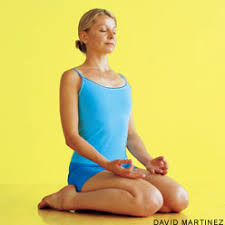For those of you who know my love of binding, twisting, and inverted poses, my latest love will surprise you. I've taken to practicing this pose daily, either before practice or just laying in bed: supta virasana.
I find that many yoga classes I take focus a lot of the back body: hamstrings, calves, back. Practicing supta virasana, I feel a deep stretch in my quads, hips, abs, and shins; my feet are forced to relax. For some reason, I find it very calming, This pose is particularly beneficial to many athletes who have overdeveloped quads, tight shins, and inflexible ankles. Cyclists can especially benefit from reclined hero's pose as the shape is almost the complete inverse of how one would posture themselves on a bike.
 |
| via mylotuslife.com |
Reclined hero's pose requires a lot of flexibility in the ankles, hips, and shoulders. If you cannot comfortably rest your sit bones on the ground while the tops of the feet are on the floor, then you should work with the upright version of hero's pose. Root your sit bones onto something, so if the floor isn't within reach, use a block to support yourself. Both poses develop flexibility in the ankles, stretch the quads, and
help protect the knees by taking the joint through its full range of motion. If you have a pre-existing knee injury, please check with your physician before practicing. Alternatively, you can practice half hero's pose by only bending one leg back, either keeping the other knee pointed towards the sky, foot planted on the floor, or extending the opposite leg (see images below).
 |
| via yogazal.com |
 |
| via melissawest.com |
Each of these variations provide the same benefits; play and find the one that allows you to relax the most while still opening through the front of the body. There is no advantage to pushing yourself into a deeper variation than you are ready for; in fact, this is actually counterproductive.
 |
| via yogajournal.com |
In either the upright or supine variation, first focus on the feet. The tops of the feet will come to either side of the hips, toes pointed in line with the lower leg; if you're more flexible or have muscular calves, you may need to move the calves to the outside of the thighs to make this more comfortable. If the ankles won't extend far enough for the tops of the feet to rest comfortably on the ground, roll up a blanket or towel to support the ankles, and stay in the upright version of the pose.
If the sit bones do not reach the floor, bring the heels under the sit bones and rest here, stacking props to close the gap between heels and sit bones. If the sit bones reach the floor and you don't feel much stretch in the quads yet, begin to recline. Coming all the way to the floor requires a lot of flexibility so have some props handy to ease yourself down. Using blocks to support the middle and upper back allows you to easily adjust the height of your props as you slowly ease into the pose; this may take months or years.
If you feel any pain in the knees, sit up and ease off the knees. If you are normally very flexible and you feel something in your knees, it could be a sign that the ligaments are being stretched. I suffered from overstretched ligaments in my knees in high school and it kept me from being able to run safely. Overstretched ligaments are very difficult to fix so avoid them by easing off from unnecessary deep stretches.
This pose is a great way to stretch and relax after a good workout, but always be mindful that you aren't pushing too far. Pain is a sign to back off, so always listen to your body.







